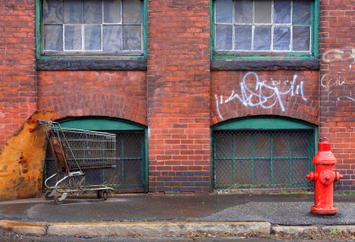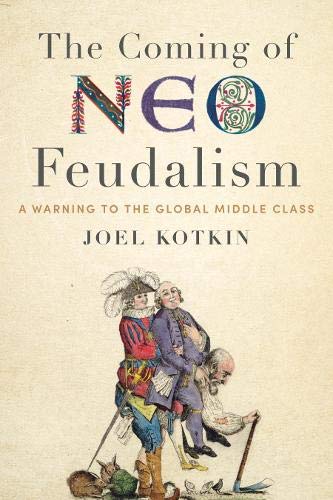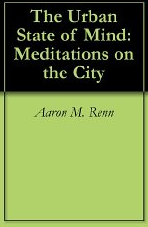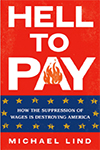
How high urban housing costs and income inequality have exacerbated urban poverty
A few years ago, on a drive from New York to Washington, I turned off I-95 in Baltimore to see H.L. Mencken’s home. Abandoned row houses lined the street, some boarded up with plywood, others simply gutted. Signs offering fast cash for houses and a number to call for unwanted cars outnumbered pedestrians. It was a landscape of rot and neglect with few signs of renewal and investment.
Writers have expended vast amounts of ink about the recent resurgence of cities, yet pockets of great poverty like West Baltimore have proven disturbingly resilient. Maryland has one of the nation’s lowest poverty rates, but is one of eight states where 70 percent of the poor are concentrated in one city. In most of the city’s schools, close to 50 percent of students qualify for federally assisted meals.
Looking at data from the 2006 US Census American Community Survey, many urban cities have poverty rates that far exceed the national level of 13.3 percent. Bronx County tops the list at 29.1 percent. The city of St. Louis and Baltimore as well as Philadelphia, Wayne (Detroit), Kings County (Brooklyn) and Denver counties all have poverty rates hovering between 19 and 27 percent.
The poverty in these communities testifies to a widening schism of income inequality distressingly common across America but most pronounced in the nation’s cities. Cost of living in cities is one key factor. The federal poverty threshold for a family of four in 2004 was only $19,157, but this number does not make an adjustment for the high rents that low-wage workers must pay to live in an urban environment.
Deborah Reed of the Public Policy Institute of California found that the poverty rates in wealthy cities like San Francisco and Los Angeles were actually significantly higher than the official rate. In San Francisco, the poverty rate was 19 percent adjusted for housing costs compared to the official ten percent; Los Angeles had a 20 percent poverty rate with the factored adjustment compared to the 16 percent official number.
Furthermore, numerous studies have documented the “high cost of being poor” in many urban areas. Low-income neighborhoods like Compton in Los Angeles (where one third of the residents are in poverty) or the Tenderloin in San Francisco suffer from a paucity of services that are plentiful in surrounding communities. Manhattan Beach has one bank for every 4,000 residents. Residents of Compton, on the other hand, can access barely one for every 25,000. Residents must make do with corner stores that sell inferior food goods at higher prices and check cashing outlets that often deduct three percent of the customer’s paycheck.
What is all this leading to? The unsettling contrasts between rich and poor of John Edwards’ “Two Americas” narrative is all too real in many American cities. Walking down Minna Street in San Francisco this week, I saw a homeless man drying his socks in the sun, just twenty yards from restaurants with $30 entrees and nightclubs so discrete in their hipness they need only signify their sign with a small letter.
And although often more startling in affluent, white-collar havens like San Francisco, this contrast exists in almost every city. In Baltimore the gap between high-earning skilled professionals living in gentrified neighborhoods with waterfront view and a procession of hard-pressed, violence-plagued communities nearby is equally striking.
The celebratory accounts of gentrification of small parts of cities like Baltimore – or large parts of sections of San Francisco or Chicago – needs to be balanced with a far greater concern with creating upward mobility for those large populations left behind. These lower income populations need to be treated as potential assets that will require investments in skills training and childcare subsidies, all the while nurturing high wage blue collar industries and improving basic public infrastructure.
In the past, poverty reduction never stuck around long enough to become a major issue in the presidential campaign, partly because voter turnout in these communities is low and, as we suggested earlier this week, there is little doubt which party will win urban voters.
But there is some reason, perhaps, to feel more optimistic this year. Senator Obama’s community organizing background in Chicago’s South Side has led him to adopt a broad anti-poverty platform targeting greater federal resources for working parents and low-income children. The presumptive Democratic nominee also proposes tripling the popular Earned Income Tax Credit that supplements low-income workers and supports pegging the minimum wage to the cost of living. Interestingly, Obama has also voiced support for creating a White House Office of Urban Policy.
Coming from a party skeptical about increasing poverty spending, McCain has supported tax credits being used to attract businesses to low-income neighborhoods and also favors increasing childcare subsidies for low-income families.
Mencken once wrote that his house in Baltimore “is as much a part of me as my two hands. If I had to leave it I’d be as certainly crippled as if I lost a leg.” However, given its current condition, it is highly unlikely today he would linger in his old neighborhood for long. Hopefully, after November, there may be reason to reassess that assumption.
Andy Sywak is the articles editor for Newgeography.com.













Marriott Family vacation
Marriott Family vacation Club Intercontinental started in 1984 along with the pursuing year, Marriott Rewards was introduced and this permitted the company to companion with timeshare resorts. marriott